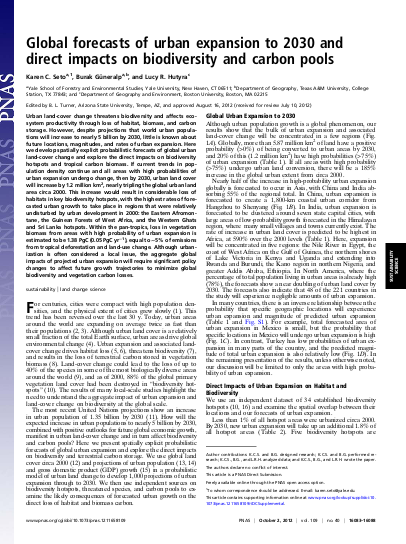
Urban land-cover change threatens biodiversity and affects ecosystem productivity through loss of habitat, biomass, and carbon storage. However, despite projections that world urban populations will increase to nearly 5 billion by 2030, little is known about future locations, magnitudes, and rates of urban expansion. Here we develop spatially explicit probabilistic forecasts of global urban land-cover change and explore the direct impacts on biodiversity hotspots and tropical carbon biomass. If current trends in population density continue and all areas with high probabilities of urban expansion undergo change, then by 2030, urban land cover will increase by 1.2 million km2, nearly tripling the global urban land area circa 2000. This increase would result in considerable loss of habitats in key biodiversity hotspots, with the highest rates of forecasted urban growth to take place in regions that were relatively undisturbed by urban development in 2000: the Eastern Afromontane, the Guinean Forests of West Africa, and the Western Ghats and Sri Lanka hotspots. Within the pan-tropics, loss in vegetation biomass from areas with high probability of urban expansion is estimated to be 1.38 PgC (0.05 PgC yr−1), equal to ∼5% of emissions from tropical deforestation and land-use change.
Although urbanization is often considered a local issue, the aggregate global impacts of projected urban expansion will require significant policy changes to affect future growth trajectories to minimize global biodiversity and vegetation carbon losses.
Links
Resource collections
- Climate emergency
- UN Habitat - Urban Response Collection
- Urban Response - Urban Crisis Preparedness and Risk Reduction
- Urban Response Collection - Community Engagement and Social Cohesion
- Urban Response Collection - Economic Recovery
- Urban Response Collection - Environment and Climate Change
- Urban Response Collection - Housing, Land and Property
- Urban Response Collection - Urban Crisis Response, Recovery and Reconstruction
- Urban Response Collection - Urban Resilience